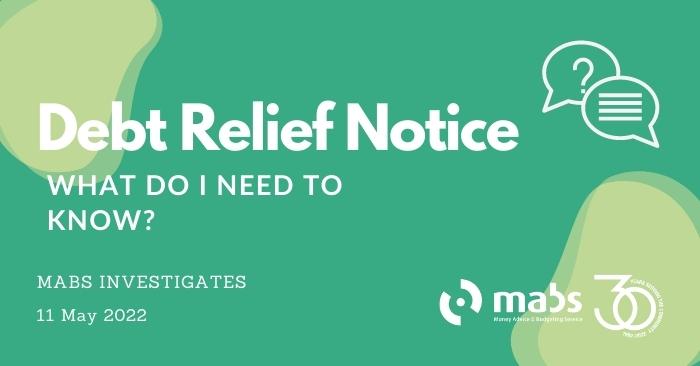Debt Relief Notice – MABS Investigates

In MABS we receive a lot of great questions about money matters and tackling debt. Questions that we know many people want to ask, but don’t know whom to ask or where to start. ‘MABS Investigates’ is here to help. In this series of blogs, we will answer these questions and “investigate” these topics, to bring clarity and break down the jargon.
The focus of this week’s ‘MABS investigates’ is Debt Relief Notices (DRN). We recently received a query on our Twitter page in relation to DRNs, so we thought we’d take the opportunity to address the topic. In this blog we’ll cover:
- What is a Debt Relief Notice (DRN)?
- How does a DRN work?
- I’m struggling with repayments on a few loans, is a DRN an option for me?
- Are there any conditions I have to meet to get a DRN?
- What are the steps to put a DRN in place?
- How long does a DRN last?
- Do I need to do anything during my DRN?
- What can the included creditors do and not do?
- Will I be able to get another loan/credit again if I go for a DRN?
What is a Debt Relief Notice (DRN)?
A Debt Relief Notice is a notice from the court stating you are not able to pay your debts listed in your DRN. It is a formal, legally binding debt solution to allow your debts to be written off after 3 years. It generally covers unsecured debt, but there are some exceptions.
How does a DRN work?
There is currently no fee to obtain a DRN and you can see if you are eligible and apply for a DRN with the help of a MABS Approved Intermediary. This is a free service – get in touch with your local MABS office to see if you are eligible and if it’s the right solution for you.
If you are granted a DRN, you do not make payments to the creditors named in the DRN unless your financial circumstances improve considerably. If your circumstances do improve during the 3-year supervision time, you must tell the Insolvency Service of Ireland (ISI) who will work out if you owe anything.
When a DRN is in place, you are entitled to a reasonable standard of living that includes food, clothing, education, health care, special circumstances and a modest allowance for savings. A DRN will last for 3 years – known as “the supervision period”. The creditors included in the DRN can no longer contact you asking you to repay these debts.
At the end of the 3 years, the debts included in your DRN will be written off. This means that you no longer owe the money. There are certain circumstances relating to your obligations under the DRN that may end the DRN process early.
I’m struggling with repayments on a few loans, is a DRN an option for me?
A Debt Relief Notice mainly covers unsecured debts. It is important to know whether your debts are secured or not. A secured loan is one where something you own is attached to the debt as insurance in case you don’t pay. Normally, a mortgage secured by your property is an example of a secured loan. But in the case of a DRN if you had a property, you would not be eligible to apply.
In general, the following debts are unsecured:
- Utility bill arrears (gas, electricity, internet and so on)
- Rent arrears
- Credit card debt
- Store card debt
- Bank overdrafts
- Unsecured bank loans
The MABS Helpline provides an initial checking service to see if you meet the eligibility criteria for a DRN. This service is free – make the call!
Before contacting the MABS Helpline for this eligibility check, you need to have all the relevant information about your debts, assets, income and circumstances. You can view the Statement of Affairs to get an idea of what you will need. But you do not have to complete it at this stage.
Are there any conditions I must meet to get a DRN?
You must meet all of the conditions below to be eligible.
You must:
- Have total ‘qualifying debts’ below €35,000. Some debts ‘qualify’ to be included automatically, some are excluded and others can be included with creditor permission.
- Be insolvent. This means you can’t pay your bills as they fall due.
- Have a disposable income of less than €60 per month – after tax, insurance, Universal Social Charge and Reasonable Living Expenses.
- Have assets below €1,500. There are allowances for things like tools for employment, an essential car or household goods.
- Live or have lived in Ireland in the past year before applying, ordinarily reside in Ireland or have a business in Ireland.
- Not have given away or sold something at a lower value than it was worth in the last 2 years.
- Not have paid one creditor more than the others in the past 2 years that also meant ‘substantially’ less money was available for other debts
- Have never had a DRN before.
Your MABS Approved Intermediary or a Money Adviser can help you see if you meet all the conditions – contact MABS to get started.
What are the steps to put a DRN in place?
You must apply for a DRN through an Approved Intermediary (AI). This person is authorised by the ISI to support you when you apply for a Debt Relief Notice. You will have to complete a Statement of Affairs giving full and honest information about your financial circumstances to the AI.
You can apply through MABS who will arrange a meeting for you with either a Money Adviser or a MABS staff member authorised as an AI. This is a free service. You can also choose an AI from the Register of Approved Intermediaries published by the ISI.
Below is a summary of the stages involved.
- Check if you are eligible by reaching out to MABS.
- Meet with your Money Adviser or AI.
- Complete your Statement of Affairs with supporting documents and send to your AI
- Meet with AI, explaining how the DRN process will work for you and if you are happy to proceed you will sign a Letter of Engagement.
- Final Meeting with AI, where your AI will sign your application and send it to the ISI – you’ll need to make a sworn declaration of your DRN application in front of a solicitor, peace commissioner or commissioner for oaths.
- Decision time, your AI will let you know if the Circuit Court has any further questions or has approved or rejected your application. If your application is approved:
- The Insolvency Service will write to you, giving you a copy of the court order and a list of the conditions that you must follow for the next 3 years.
- Your name will be put on a public Register of Debt Relief Notices
If your application is rejected, a Money Adviser can work with you to find another solution.
How long does a DRN last?
3 years.
If you would like to exit the DRN process early, you can pay half of the total qualifying debt and the rest will be written off.
A DRN can also end early if the court decides to terminate it based on a successful creditor objection. Any change in circumstances listed under “Do I need to do anything during my DRN?” can also affect the duration of a DRN.
Do I need to do anything during my DRN?
During the supervision time (3 years) you must inform the ISI if:
- You become aware of any error, or something left out in the information sent to the ISI.
You have a ‘material’ (big) change in financial circumstances (income, assets, debts). The ISI will work out if you will need to use some of the money to make repayments. You must tell the ISI if:
- Your income increases by €400 or more per month. This could be from returning to work, an increase in hours or getting a promotion. If this happens, you must submit half of the full increase to the ISI for payment to your included creditors.
- An income increase is calculated by comparing your new income, to either your income or your Reasonable Living Expenses at the time of your application, and using whichever figure is higher.
- Income is calculated after tax, social insurance payments, levies, and payments made to any debts excluded from the DRN.
- When half of the included debt has been paid, the other half will be written off ending the DRN
- You receive a gift or payment of €500 or more. This payment could be an inheritance, compensation or a gift. If this happens, you must then give half of this amount to the ISI to share between creditors, paying up to the entire amount of the included debts.
During the supervision time, you must tell the lender that you are a ‘specified debtor’ if you wish to get credit (a loan) of more than €650.
What can the included creditors do and not do?
Details of all your debts are listed in your application, but all of them may not be included for write off. For example, debts like damages awarded by a court, a domestic support order or debts arising from a criminal offence are excluded, and debts like money owed to Revenue can be included but only with creditor permission. MABS can tell you more about which debts can and can’t be included.
A creditor whose debt is included in the DRN cannot:
- Start or continue legal action in relation to that debt
- Contact you for payment (unless you ask them to)
- Enforce a judgment or court/tribunal order
- Apply for or proceed with action to make you bankrupt
- Take steps to repossess goods, unless the creditor owns them or has security (such as hire purchase)
A creditor can still take action against another person jointly named in the debt or named as a guarantor unless they too have an insolvency debt solution in place.
A creditor can apply to court to object to your DRN during the supervision time, but only in very limited circumstances.
You can read more in the Insolvency Service of Ireland’s DRN guidebook (pdf).
Will I be able to get another loan/credit again if I go for a DRN?
Each lender makes its own decisions on whether to lend or not and will often be guided by the Central Credit Register. Before you start the DRN process, it is highly likely that your debts will have been recorded on your credit report from the Central Credit Register.
By going through and exiting the DRN process your included debts will be written off. Since there is no reporting requirement from the ISI to the Central Credit Register and there is no classification for insolvency on the Central Credit Register, it is the responsibility of the creditor to keep lending records accurate and up to date. You have rights if creditors do not do this.
During the supervision time of the DRN, you must tell the lender that you are a ‘specified debtor’ if you wish to get credit (loan) of more than €650.
Entering into an agreement such as a DRN should show potential lenders that you are proactively addressing your financial situation and on completion of the DRN you will be solvent, which could make you more eligible to obtain credit in the future. However, the decision on whether or not to give credit is always up to the lender.
To conclude
We know that DRNs and indeed all insolvency matters are complex by nature. We hope that we have clarified the DRN process in this blog.
Do you have a question for MABS to Investigate? Get in touch and let us know at mabs@ciboard.ie.
If you have a query for one of our advisers or are struggling with your debts, you can call the MABS National Helpline on 0818 07 2000 Monday to Friday, from 9am to 8pm or find the contact details for your local office.
Disclaimer: This blog does not represent legal advice and is intended for guidance only. If you are concerned about your current or future personal financial situation, then please contact an adviser from MABS. Advisers are available by phone and email.
Note: We welcome references to and use of the content in this blog. However, please reference MABS, and link said content if you choose to do so




Facebook
twitter
Instagram